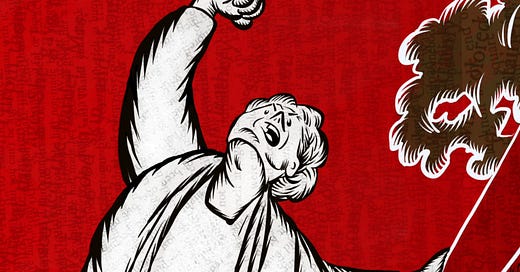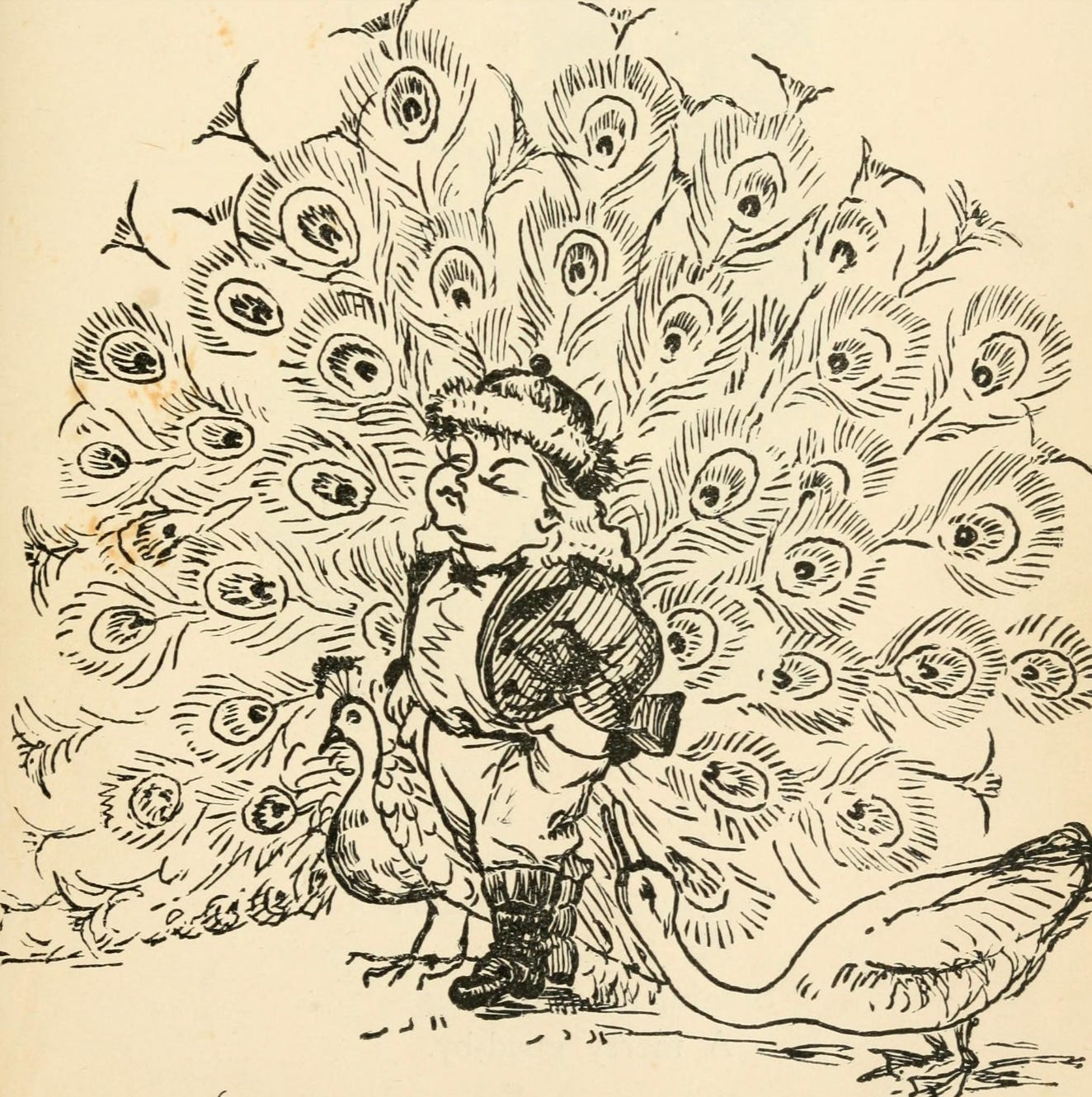Welcome to Flight School and the promised series of teachings on the remarkable Flannery O’Connor.
If you are a serious creative writer, O’Connor is a teacher who continues to educate and illuminate us sixty years after her death. Her teaching is in the writing itself for “those who have eyes to see.”
To get the most out of this teaching, read the story first. You won’t regret it.
The Last Shall March First
"Until the sun slipped finally behind the tree line, Mrs. Turpin remained there with her gaze bent to them as if she were absorbing some abysmal life-giving knowledge. At last she lifted her head. There was only a purple streak in the sky, coming through a field of crimson and leading, like an extension of the highway, into the descending dusk. She raised her hands from the side of the pen in a gesture hieratic and profound. A visionary light settled in her eyes. She saw the streak as a vast swinging bridge extending upward from the earth through a field of living fire."
- Flannery O'Connor, "Revelation"
Revelation is the last story O’Connor wrote, and like Jessica Hooten Wilson tells us in her commentary on this story (watch here), it was written in her hospital bed, hidden from doctors who didn’t want her to be working. At this point, as Wilson also points out, O’Connor had spent years of her life in such waiting rooms. She knew them in a terrible, intimate way. How perfect she would write this story then, her last, about what she knew so very well.
The scenes in "Revelation" and how they progress:
As a teacher, I’m always interested in the arrangements of the scenes and then in the progression of the action through each one:
The Doctor's Office - This opening scene establishes everything and plants the seeds for what follows
The Drive Home - Ruby begins the agonizing processing of the Mary Grace accusation against her. “Wart hog from hell”
The Bedroom with Claude - The confrontation progresses from shock to absorption to her psyche, culminating in denial.
The Front of the House - Ruby giving water to workers and sharing her next phase of absorption with the workers who agree with her about its unfairness (three phases of absorption, the number of transformation)
The Barnyard - Ruby questions God and receives her vision
This is a perfect template for all writers to both analyze and apply. Each scene builds on the next and rises to a form of resolution (in this case, lack of resolution because we don’t know how Ruby will fare with this humbling vision).
Characters in the doctor's office
Next, let’s study the setup. I tell writers here at Flight School—and at the more advanced Blackbird Studio—that all the work lives in the opening. You are, in essence, telling the entire story in your first 20/25%. That’s why openings are so challenging to craft and why you need to get to your ending a few times to see what you are creating.
O’Connor’s opening scene is long in contrast to others. Why? O’Connor is giving the reader that interminable sense of “waiting” that we all have to go through in our lives. In this opening, you feel like you’re tapping your own foot. Ready to go already. Checking your watch. But no…you must wait.
O’Connor also uses this terrible waiting to build out a microcosm of Southern society, with each character representing a different social stratum and allowing the reader to see Ruby's self-perception:
Ruby Turpin - Our protagonist, whose smug self-satisfaction and obsession with social hierarchy drive the whole story. She categorizes people and thanks God she wasn't made black, “or white-trash, or ugly."
Claud Turpin - Ruby's husband with the ulcerated leg that brings them to the doctor and tries to temper Ruby's more blatant judgments.
The "White-Trash" Woman - In dirty yellow sweatshirt and slacks, she is hostile to Ruby, and her statements about sending "them all back to Africa" reveal her bigotry.
The "White-Trash" Woman's Boy - He has a"rusty" face full of sores and a running nose and embodies for Ruby the poor upbringing she associates with "white trash."
The "Well-Dressed, Pleasant" Woman, who is also Mary Grace's Mother - Stands in for the "respectable" middle class Ruby aspires to be associated with.
Mary Grace - A "fat girl" and college student reading a book called "Human Development." Her growing rage at Ruby's self-satisfied monologue culminates in throwing her book at Ruby and calling her "a wart hog from hell."
The Black Delivery Boy - He is a brief but significant presence who shows deference to whites, reinforcing Ruby's worldview that everyone should "stay in their place."
The Nurse - Professional figure who maintains order in the waiting room and tends to Mary Grace after her outburst.
The Doctor - Mostly off-stage but represents professional authority who sedates Mary Grace. This is the sedation that allows Ruby (and others) to sedate themselves by such hierarchies that, in the end, do not exist in the higher realms.
Social hierarchy rearrangement
What makes this setup and opening scene so powerful is how O'Connor arranges these characters in Ruby’s mind.
Black people (at the bottom of her hierarchy)
"White trash" (whom she considers lazy and dirty, but a nudge up the ladder)
The stylish, wealthy woman (Mary Grace’s mother) is her equal.
Mary Grace is below her, by age, but not far, teetering next to the mother on the social ladder.
The characters then serve as catalysts, with Mary Grace functioning as the unexpected prophet who delivers a divine message of harsh truth to the self-satisfied Ruby.
Vision → Inversion
In the final scene of this story, Ruby's vision is the reversal of her carefully maintained social order. Those she considered beneath her—"whole companies of white trash, clean for the first time in their lives, and bands of black [people] in white robes, and battalions of freaks and lunatics"—all march toward heaven "with great dignity, accountable as they had always been for nothing."
Meanwhile, "decent" people like herself and Claud bring up the rear, still maintaining their virtuous behavior but not first in this heavenward procession. Their "shocked and altered faces" show they recognize—perhaps for the first time—that their so-called virtues count for little in the larger economy of grace.
This vision isn't labeled as Purgatory, but it suggests a purgatorial reordering of Ruby's soul. She must unlearn her pride and self-satisfaction before she can enter grace.
The scene at the pig parlor represents Ruby at her lowest point, questioning the divine order, and this “revelation” is still in progress as the story ends. Will Ruby get it? Awaken? Transform with the few years she has left on earth? Or will she revert to her old, patterned, head-hearted ways?
This is what we are left with in the end: Questions each of us could ask ourselves on the journey toward the inevitable.
The Creative Writer's Gold: Notice how O'Connor reveals character through judgment. Ruby categorizes everyone around her—the "white-trash" woman, the "well-dressed lady," the "pleasant" Black delivery boy. These judgments tell us everything about Ruby and nothing about the people she's judging, and this keeps our eye on our hero the whole time.
✍️ Your Turn:
Prompts that push us to look deeper into ourselves
The Waiting Room: Write a story set in a waiting room, or a line at the store, or in traffic, or the bus, or a train, where people from different social backgrounds are forced to interact. Create tension through judgment and have one character experience a profound shift in perspective by the end of the scene.
Hierarchy Reversed: Create a character who takes pride in her social position (you don’t have to go too far, grabbing from the extreme of Left and Right positions these days). Write a scene where this person experiences a vision or dream in which all assumptions about status and worth invert. How does this challenge change them?
The Unwelcome Prophet: Write about a character who receives a harsh truth from someone they consider beneath them, or unqualified to judge them. Explore how they reject the message but come to recognize its validity.
Post in the comments and show me what you’ve created. I can’t wait.
Thanks for being with me! Next stop, Everything that Rises Must Converge.
Enjoy, Jennifer 🐦⬛
















Share this post